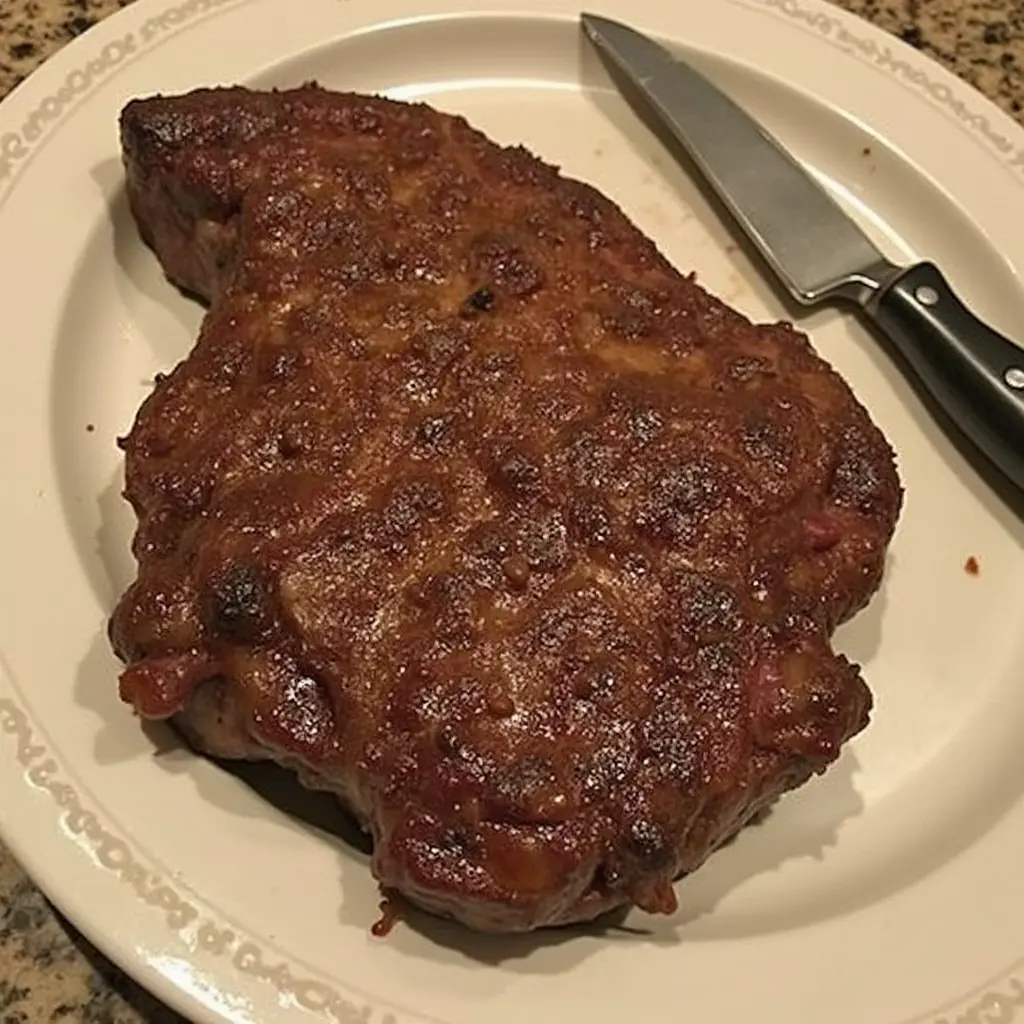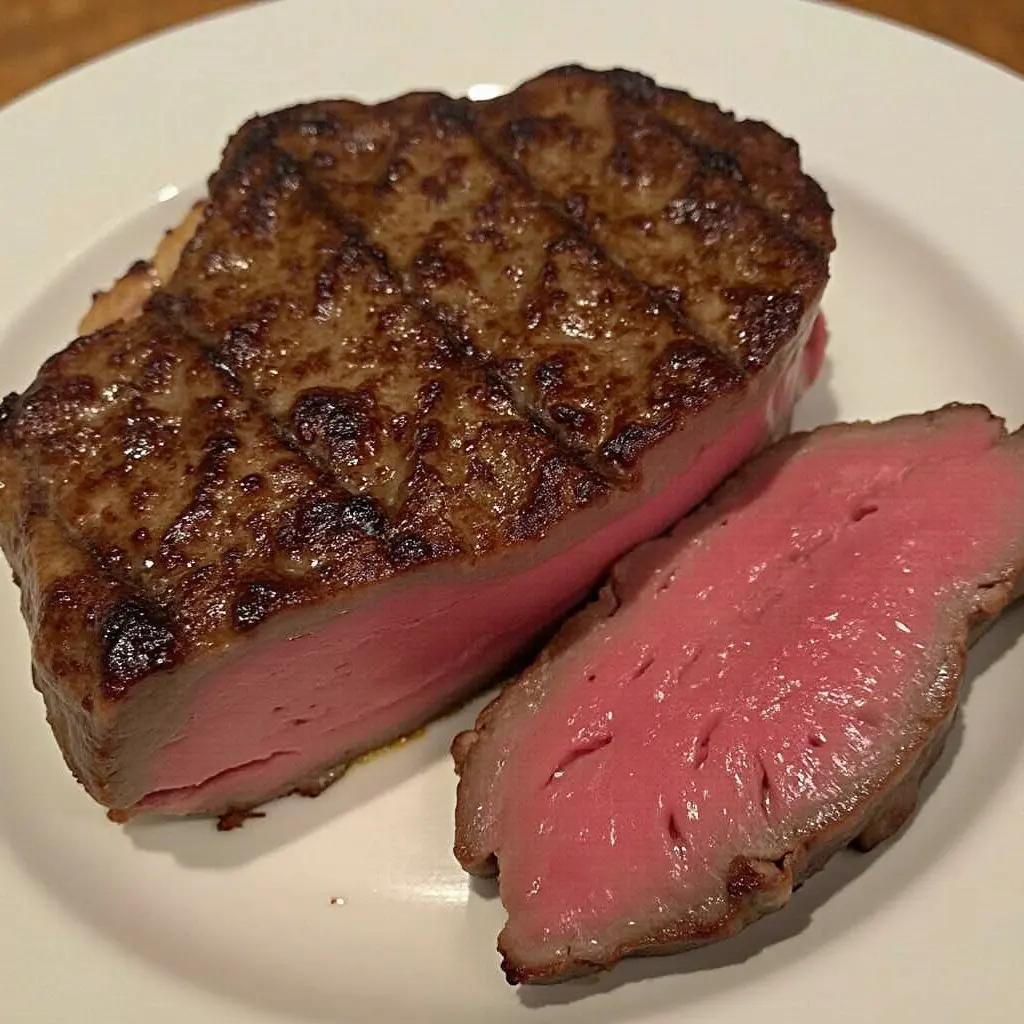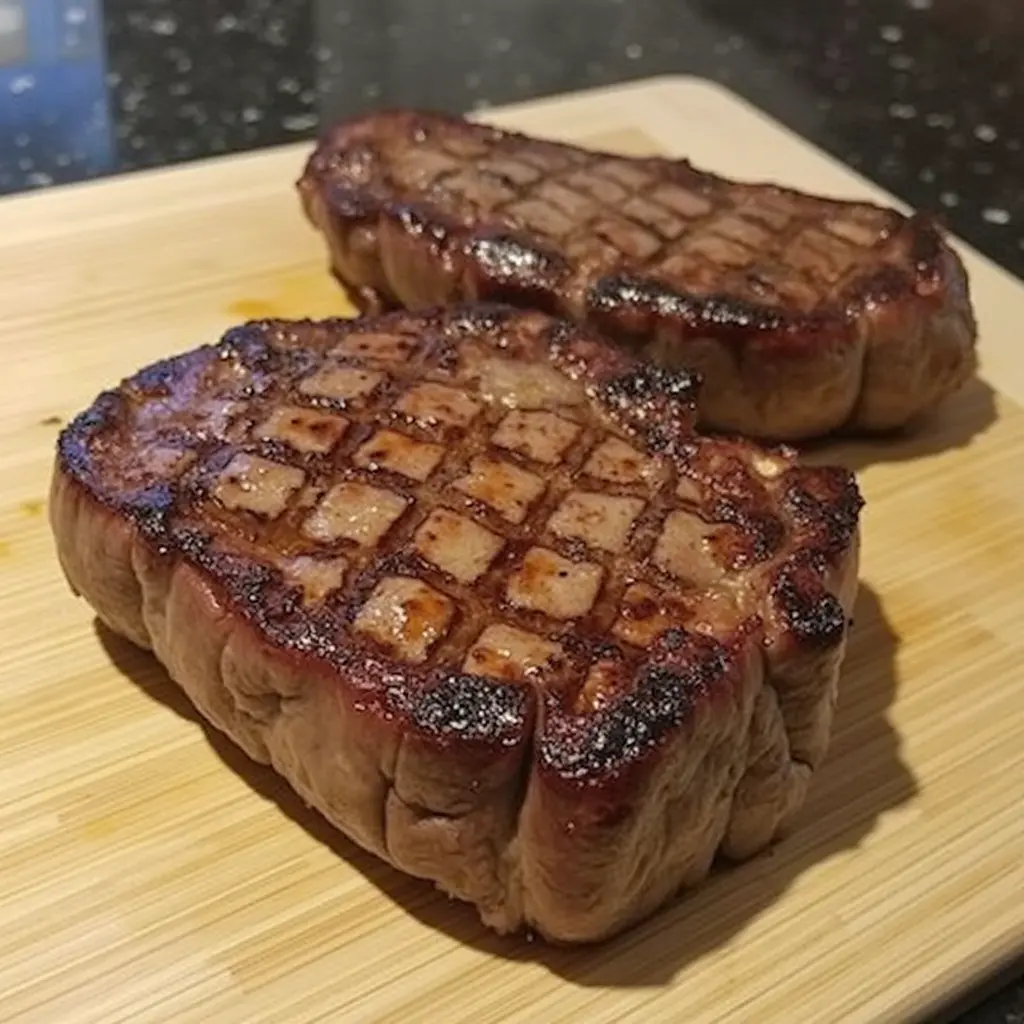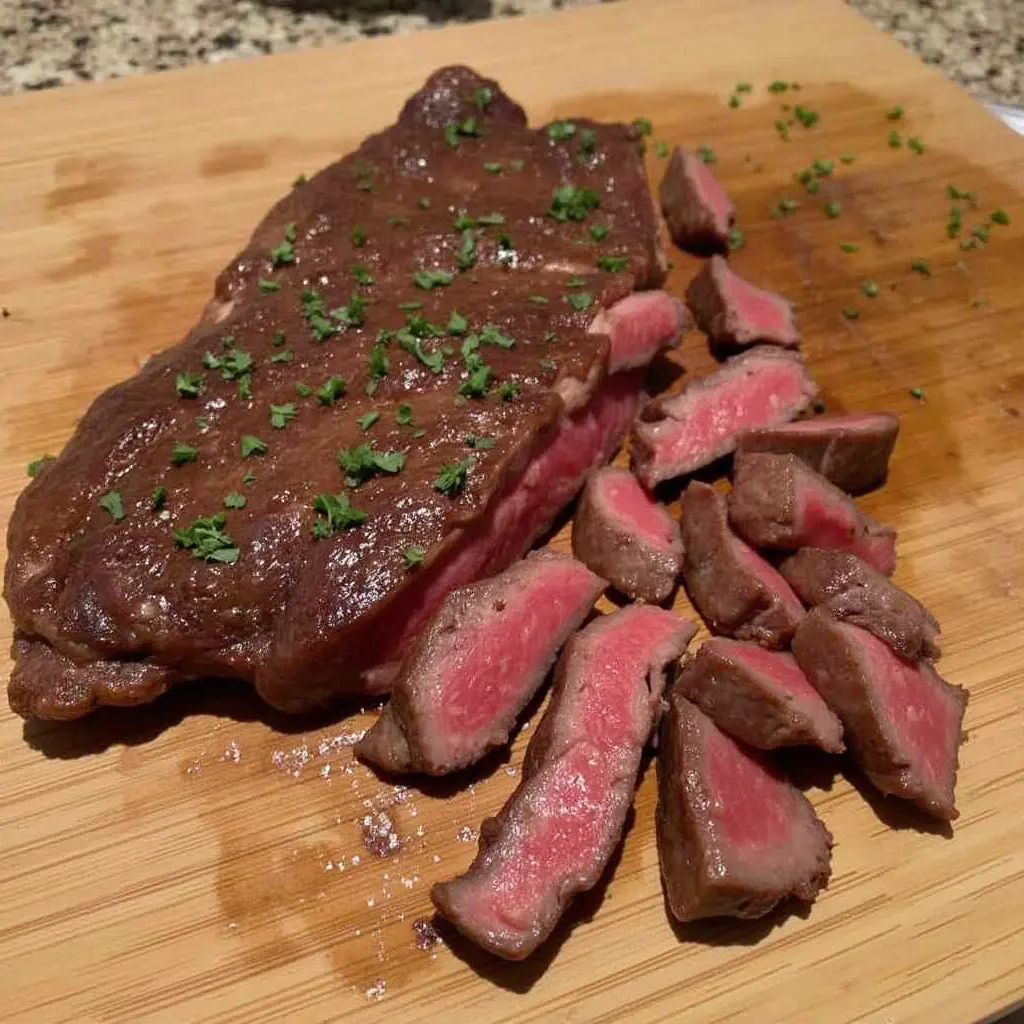The sizzle of a perfectly cooked steak can turn a simple meal into a memorable experience. As a home cook who’s spent many nights perfecting steak, I know the art and science of cooking a flat iron steak.
Cooking a flat iron steak is more than just throwing meat on a hot grill. It’s about knowing the cut, controlling the temperature, and bringing out the flavors. This guide will help you cook a flat iron steak that’s as good as any restaurant dish.
Mastering flat iron steak cooking takes precision and knowledge. You’ll learn how to choose the right cut and control the temperature. This will help you create a delicious meal that will wow your family and friends.

Key Takeaways
- Understand the unique characteristics of flat iron steak
- Learn multiple cooking methods for perfect results
- Master temperature control for ideal doneness
- Discover marinading and seasoning techniques
- Recognize the importance of resting meat after cooking
Understanding Flat Iron Steak: A Premium Cut
Flat iron steak has changed the game in home cooking and professional kitchens. It’s known for its top-notch quality and flexibility. Meat lovers are now eager to master cooking this premium cut.

Learning about this cut can take your steak recipes to the next level. Let’s dive into what makes it so unique.
Anatomy and Characteristics of Flat Iron Steak
Flat iron steak comes from the cow’s shoulder. It’s known for its rich marbling, which adds flavor and tenderness. Its rectangular shape and even thickness are ideal for different cooking styles.
- Originating from the chuck primal cut
- Extremely tender muscle section
- Consistently well-marbled texture
- Minimal connective tissue
Why Flat Iron Steak Is Popular Among Chefs
“The flat iron steak represents the perfect balance between flavor, tenderness, and affordability.” – Professional Chef
Chefs love this cut for its consistent quality and flexibility. Its bold beef taste and soft texture are perfect for many dishes.
Nutritional Profile and Benefits
| Nutritional Component | Amount per 3 oz Serving |
|---|---|
| Protein | 22g |
| Total Fat | 8g |
| Iron | 1.8mg |
| Zinc | 4.5mg |
Flat iron steak is full of good stuff like protein, iron, and zinc. It’s lean, making it great for those who care about their health. It’s perfect for those looking to try new steak recipes.
Essential Equipment for Cooking Flat Iron Steak
Cooking a perfect flat iron steak needs more than skill. The right tools can make your grilling or pan-searing experience better. Professional chefs know that good tools are key in cooking meat.

Choosing the right cooking tools is key for top-notch results. Here are the must-haves:
- Cast Iron Skillet: The best for pan-searing flat iron steak
- Heavy-duty grill or grill pan
- Meat thermometer
- Long-handled tongs
- Sharp chef’s knife
- Cutting board
Each tool has its own role in steak preparation. A good meat thermometer ensures the steak is cooked just right. Cast iron skillets, on the other hand, distribute heat well for a tasty crust.
| Equipment | Purpose | Recommended Type |
|---|---|---|
| Cast Iron Skillet | Even heat distribution | 12-inch pre-seasoned skillet |
| Meat Thermometer | Check internal temperature | Digital instant-read |
| Grill | High-heat cooking | Gas or charcoal with temperature control |
“The right tool can elevate a good steak to a great dining experience.” – Professional Chef’s Insight
Invest in quality equipment for consistently great flat iron steak cooking.
How Should a Flat Iron Steak Be Cooked?
Cooking a flat iron steak needs precision and care. This ensures its rich flavor and tender texture. The right method can make this cut a top-notch meal at home.
Preparing Your Steak for Cooking
Before cooking, follow these key steps:
- Remove the steak from the fridge 30-45 minutes before cooking
- Pat the steak dry with paper towels for better searing
- Season it well with kosher salt and fresh black pepper
- Let the steak warm up to room temperature for even cooking
Temperature and Timing Guidelines
Knowing the cooking times for a flat iron steak is key. Each level of doneness has its own temperature and time:
| Doneness Level | Internal Temperature | Cooking Time |
|---|---|---|
| Rare | 125°F | 3-4 minutes per side |
| Medium Rare | 135°F | 4-5 minutes per side |
| Medium | 145°F | 5-6 minutes per side |
Resting and Serving Tips
Getting the steak right isn’t just about cooking. After cooking, let it rest for 5-7 minutes. This step lets juices spread evenly, making the steak moist and flavorful.
“A perfectly rested steak is the secret to restaurant-quality results at home.” – Professional Chef
Pro tip: Use a meat thermometer to check the internal temperature. This helps you get the exact doneness you want.
Mastering the Perfect Marinade
Marinating flat iron steak makes it even more delicious. The right marinade tenderizes the meat and adds amazing flavors. This makes your flat iron steak recipes even better.
Learning to marinate is an art. It’s about making your steak truly special. Let’s look at some techniques that will change your cooking.
- Choose acidic components like citrus or vinegar to break down muscle fibers
- Select complementary herbs and spices for depth of flavor
- Maintain proper marinating times to prevent meat breakdown
“A great marinade is like a symphony – every ingredient plays a crucial role in creating harmony.” – Professional Chef
For marinating flat iron steak, try these classic mixes:
| Marinade Style | Key Ingredients | Marinating Time |
|---|---|---|
| Classic Herb | Olive oil, rosemary, thyme, garlic | 2-4 hours |
| Asian-Inspired | Soy sauce, ginger, sesame oil, honey | 1-3 hours |
| Spicy Southwest | Lime juice, chili powder, cumin, cilantro | 1-2 hours |
Pro tip: Always marinate in a non-reactive container and refrigerate. This prevents bacterial growth. Your flat iron steak recipes will be better for it!
Pan-Searing Techniques for Restaurant-Quality Results
Mastering pan-searing flat iron steak needs precision and skill. Professional chefs turn an ordinary cut into a special meal. Cooking flat iron steak well requires focus and specific techniques that make your meal better.
Achieving the Perfect Crust
A great crust is key to amazing flat iron steak. Here’s how to do it:
- Choose a heavy-bottomed cast-iron skillet
- Heat the pan until it’s very hot
- Pat the steak dry with paper towels
- Use oil that doesn’t smoke easily, like avocado or grapeseed
Butter Basting Methods
Butter basting makes the steak taste richer. Here’s how to do it:
- Add butter in the last 2-3 minutes of cooking
- Keep tilting the pan and spooning melted butter over the steak
- Add fresh herbs like thyme or rosemary for more flavor
Common Pan-Searing Mistakes to Avoid
Here are tips to avoid common mistakes:
| Mistake | Solution |
|---|---|
| Overcrowding the pan | Cook steaks separately to keep the heat high |
| Moving steak too often | Let it get a crust before flipping |
| Incorrect temperature | Use medium-high heat for the best sear |
*”The secret to restaurant-quality steak is patience and technique.”* – Professional Chef’s Wisdom
By using these expert techniques, you can make your flat iron steak taste like it’s from a restaurant. It will impress everyone.
Grilling Your Flat Iron Steak to Perfection
Grilling flat iron steak needs precision and skill. You want to make a meal that highlights its rich flavor and tender texture. The key to grilling well is knowing the right techniques and cooking times.
Before grilling your flat iron steak, get your grill ready. Here’s what to do:
- Preheat the grill to high heat (around 450-500°F)
- Clean and oil the grates to prevent sticking
- Pat the steak dry with paper towels
- Season generously with salt and pepper
For flat iron steak cooking times, timing is crucial. For a perfect medium-rare, follow these guidelines:
| Doneness | Grill Time | Internal Temperature |
|---|---|---|
| Rare | 3-4 minutes per side | 125°F |
| Medium-Rare | 4-5 minutes per side | 135°F |
| Medium | 5-6 minutes per side | 145°F |
Pro tip: Use a meat thermometer to ensure accurate cooking temperatures.
“The key to grilling flat iron steak is maintaining consistent heat and avoiding excessive flipping.” – Grilling Experts
After grilling, let your steak rest for 5-10 minutes. This lets the juices spread, making it juicy and tender. Slice against the grain for the best tenderness. Enjoy your perfectly grilled flat iron steak!
Temperature Guide for Different Levels of Doneness
Getting your flat iron steak just right needs precision and knowledge. A good steak temperature guide ensures you cook it perfectly every time.
It’s key to know the right internal temperature for a tasty steak. The doneness level greatly affects the steak’s taste and feel.
Using Meat Thermometers Correctly
To get the steak’s temperature right, put the thermometer in the thickest part. Make sure not to hit bone or fat, as this can mess up the reading.
- Always clean your thermometer before and after use
- Insert the probe at a slight angle
- Wait a few seconds for an accurate reading
Visual Indicators of Doneness
While thermometers are the most accurate, chefs also look for visual signs to check the steak’s doneness.
| Doneness Level | Temperature | Visual Characteristics |
|---|---|---|
| Rare | 125°F | Very red center, soft texture |
| Medium Rare | 135°F | Warm red center, slight firmness |
| Medium | 145°F | Pink center, firmer texture |
| Medium Well | 150°F | Slight pink center, more firm |
| Well Done | 160°F | No pink, completely brown |
Pro tip: Remember that steak continues cooking during the resting period, so remove it from heat slightly before reaching your desired temperature.
Best Seasonings and Rubs for Flat Iron Steak
Turning your flat iron steak into a masterpiece starts with the right seasoning. Learning how to season can make your cooking better. It will also make your taste buds happy with deep, rich flavors.
When you’re looking at flat iron steak recipes, picking the right seasoning is key. The right mix can bring out the meat’s natural taste and make a delicious crust.
- Classic Salt and Pepper Rub
- Kosher salt
- Freshly ground black pepper
- Coarse grind for maximum texture
- Southwestern-Inspired Blend
- Chili powder
- Smoked paprika
- Cumin
- Garlic powder
- Herb-Infused Seasoning
- Dried rosemary
- Thyme
- Oregano
- Cracked black pepper
Pro tip: Rub your chosen seasoning all over the steak at least 30 minutes before cooking. This lets the flavors soak into the meat.
| Seasoning Type | Key Ingredients | Flavor Profile |
|---|---|---|
| Classic Blend | Salt, Pepper | Traditional, Robust |
| Spicy Rub | Cayenne, Chili Powder | Bold, Intense |
| Herb Mix | Rosemary, Thyme | Earthy, Aromatic |
“A great seasoning doesn’t mask the steak’s flavor—it amplifies it.” – Chef Michael Roberts
Keep in mind, different recipes might need different seasonings. Try out different mixes to find your favorite.
Serving Suggestions and Pairing Recommendations
To make your flat iron steak truly special, think about how you serve and pair it. The way you present and what you serve with it is just as important as how you cook it.
Choosing the right side dishes can turn your flat iron steak into a memorable meal. Here are some top picks:
- Roasted Vegetable Medley: Colorful roasted root vegetables complement the rich flavor of flat iron steak
- Creamy garlic mashed potatoes for a classic comfort combination
- Grilled asparagus with herb butter
- Quinoa salad with fresh herbs and citrus vinaigrette
Wine pairing can make your meal even better. Bold red wines pair well with flat iron steak:
- Cabernet Sauvignon
- Malbec
- Syrah/Shiraz
“The right accompaniment can elevate a great steak from delicious to unforgettable.” – Professional Chef
To impress, slice your flat iron steak against the grain. Place it on a warm platter. Add fresh herbs like rosemary or thyme for a pop of color and scent.
Conclusion
Cooking a flat iron steak is an art that combines technique, passion, and meat preparation knowledge. You’ve learned key methods for cooking this exceptional cut. These include pan-searing and grilling techniques.
You now know how to control temperatures, pick the right seasonings, and check for doneness. Each method brings unique flavors and textures. This lets you tailor your cooking to your taste and what you have.
Practice is key. Try different marinades, cooking surfaces, and resting times to find your style. The most important thing is patience, attention to detail, and a willingness to learn.
With this knowledge, you can make a simple flat iron steak into a meal that wows everyone. Use your new skills to create delicious dishes and enjoy the process.

